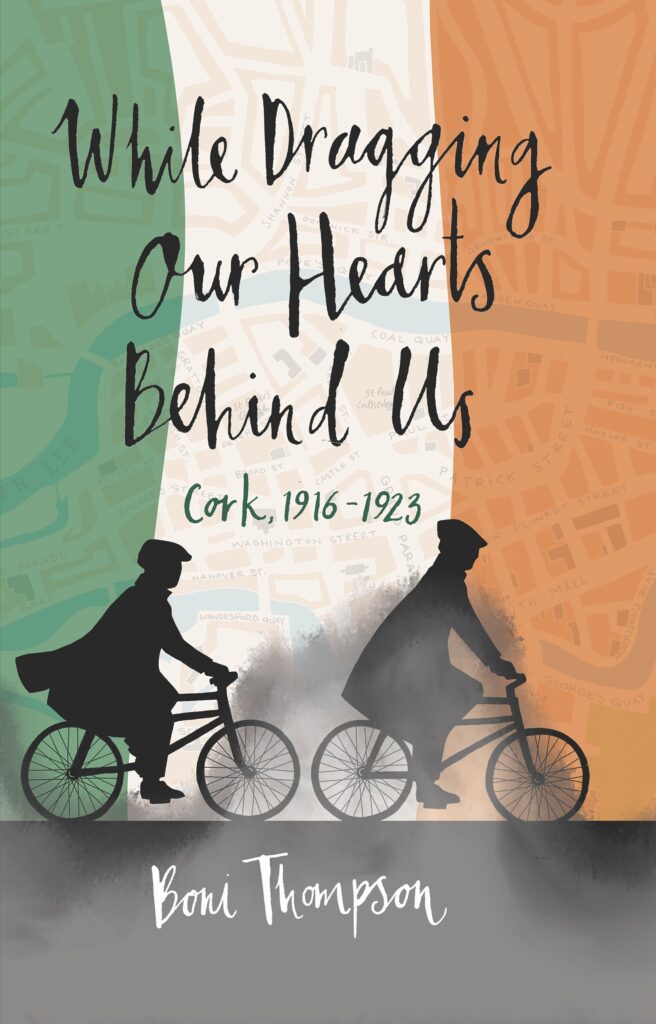Your basket is currently empty!
Category: Uncategorised
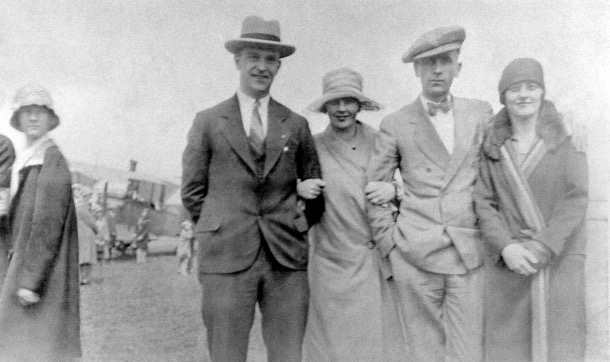
While Dragging Our Hearts Behind Us: The Photographs
by Boni Thompson, author of While Dragging Our Hearts Behind Us.
St. Patrick’s Day is a fitting day to reflect on the publication of my grandfather’s story, 101 years after the end of the Irish Civil War, and therefore 101 years since my grandfather James left Ireland behind him. Evading the inevitable round-up of irregulars, those who were on the losing side of the war, he made his way from Liverpool to St. John, New Brunswick, Canada, and once he had worked his way by train to Toronto, sought out the assistance of Clan na Gael, a somewhat secret society of Irish Americans who passed him through customs at Niagara Falls, and took him to New York City. There he found Peter MacSwiney, brother to his good friend Sean, and the late mayor of Cork, Terrence. Peter took him in, helped him land a job quickly, and opened his eyes to everything that a world metropolis could offer, so different from a small remote city in the south of Ireland.
I have very few pictures of my grandfather James, Intelligence Officer, Active Service Unit member and Flying Column member of the Cork No. 1 Brigade during the Irish War of Independence. After scouring the internet many times for photographs of IRA members from 1916 and onward, I soon realized he is nowhere to be found. I am quite sure this is completely intentional on his part. The thought comes to mind that it may have been a covert policy of sorts with the early IRA to avoid being photographed. Afterall, part of how they won that war was being able to walk down the street with complete anonymity. Then again, maybe it was just good common sense. We know that leaders such as Michael Collins in Dublin and Sean O’Hegarty in Cork expected no less. I do believe it was an unspoken expectation that identities of perpetrators of various types of acts, whether violent or not, remained nameless and unrecorded. And, when looking through witness accounts, though many names are divulged for certain actions, many more are very difficult to find, despite the leadership capacities that such names implied.
This of course leads to the realization that keeping their faces and identity off the British radar was a matter of life and death for men such as James. Indeed, looking for photographs of other Intelligence unit members was also a pointless endeavour. Even the last name of his friend Mick, who travelled with him to New York City, remains a mystery to me. He may have been the Intelligence Officer Mick Leahy, or he may not have been.
Later, when they had been in America for some time, James and his Irish friends must have loosened up somewhat. Perhaps they did not think they would ever return. Or perhaps they thought that American pictures would stay in America. I have a grand total of two photos of James and his Irish compatriots taken in the mid to late twenties. They say a lot about his life there.
Pictures are a window through time. They are by definition reflections of the past, and as such they can be revelatory far beyond the subject’s awareness. The old adage ‘A picture is worth a thousand words’ may be true, looking at the subject(s), noticing the telling signs of emotion, the body language of stance and expression, the eyes, laughing, crying, suffering, joyous… such a tiny body part that can tell the reader so much. The background often gives us time frames, the model of car, the style of house, the fashion of bystanders, the skyline of cities. All of this leaks information about the subject, answering questions of who, what, where, when, sometimes how, but rarely, something which can be the most tantalizingly human question of all, why.
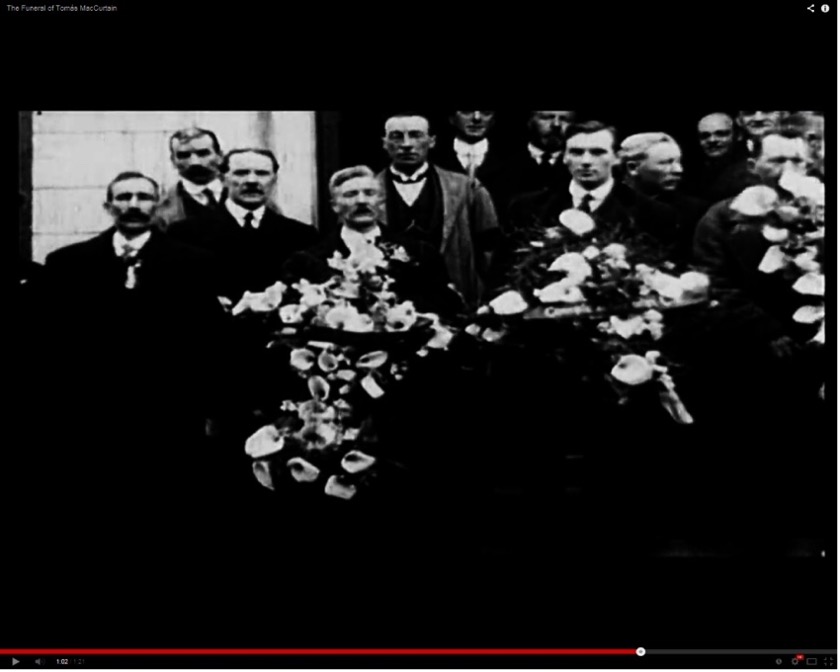
James and O’Hegarty leaving Tomas MacCurtain’s funeral. James holding flowers centre. O’Hegarty to the left of him. Behind them are a who’s who of the Cork Brigade, Pa Murray, Sandow, and others. This is a still picture taken from a video about MacCurtain’s funeral, posted on Youtube. This picture was a surprising find. A completely serendipitous accident. The clip lasted only about 5 seconds within a larger 1-minute montage of shots of the funeral. This event occurred four years after the Easter Rising but just a few short months before O’Hegarty’s rise to Commander. James’ face is young. He is 21 years old in this shot. The tell-tale identifiers of his face, the straight mouth, the high pops of cheek bone protruding, his left ear lobe straight as an arrow, points out from his face without a curve. These were what I looked for to authenticate him in the film clip because he looks so innocent here, perhaps yet idealistic and unaware of just how terrible the fight would become. Indeed, it had barely started.
Contrast the above face with the picture below:

I call this the Amelia picture. James stands with George Putnam, Amelia Earhart, on his right, his soon to be wife on his left. He is about 29 years old, it is eight years later, the War has come and gone, the Civil War but a fading memory. The other three members of the group are obviously enjoying themselves. Notice the girl on the far left, staring at the famous couple and their friends, the planes in the background. But focus in on James’ face. He is a very different man. Notice the steely eyes, the lack of expression, no trace of humor, only the somewhat displeased stare. 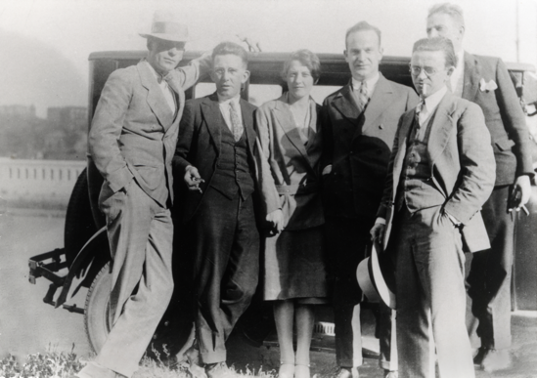
Here James leans against the car beside his friend Mick, two other familiar faces from Cork, but whose names remain unknown, and at the rear, partially obscured, Connie Neenan, a fellow officer from Cork No.1 Brigade. 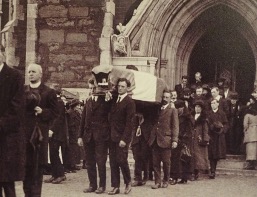
Peter and Sean MacSwiney carry the front of their brother’s coffin out of the Cathedral in Cork City, October 31st 1920. The effects of hunger strike, especially hunger strike resulting in death by starvation are difficult to imagine. The resolve of the men and women who undertook this extreme act of political defiance is for me, almost impossible to picture. Yet many men and women did undertake this. The fact that the outrage of the British public pressured their government to release such prisoners tells us that the effect on on-lookers, was also devestating. The death of Thomas Ashe by forcefeeding, after he undertook to hunger strike, left a horrific scar on people everywhere. 60 years after the fact, James was almost despondent describing the tragic event to me, even though Thomas Ashe was someone he never actually met in person, though a well admired and respected leader through the Easter Rising and afterwards.
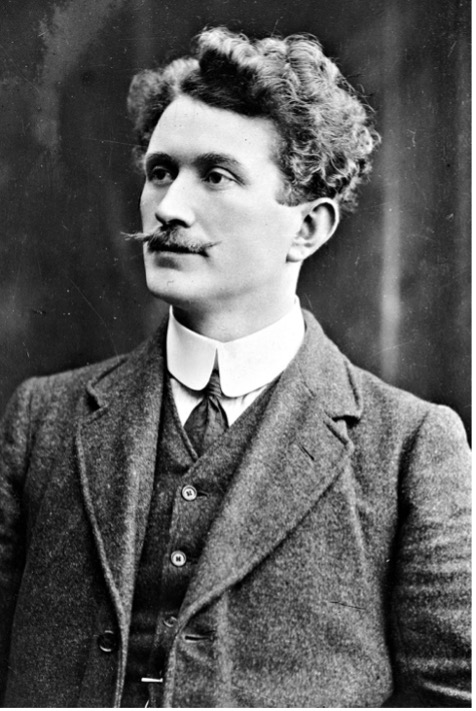
Thomas Ashe, educator, principal, musician, leader during the Easter Rising. 
The Wallace sister’s tobacco shop. The church style window is above the door to the Wallace sisters’ shop, secret meeting place of the Cork No 1 Brigade. This probably indicates that the property belonged to St. Augustine’s Church directly across the laneway from the door. This picture was taken in the 1960’s. The property can still be found today, but the window above is now missing. Today, the laneway through which much of the IRA leadership walked up and down throughout the War of Independence looks much different than in the photo above. There is no indicator or historic plaque to mark the tremendous contribution that the Wallace sisters made to the fight in Cork City, caring for members of the Brigade, passing messages, working with Cumann na Ban, the women’s organization, and tending to top secret directives from the 3 Officers Commanding, each in his turn, not to mention the daily risks undertaken as a secret meeting place, day and night. Is it because they are women? Maybe. But remember also that O’Hegarty, the fierce commander who took over after the first two republican mayors, MacCurtain and MacSwiney, also seems to be forgotten to Cork history.
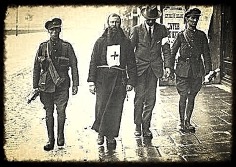
Father Dominic under arrest. This was a devastating blow to many religious men in the Cork No 1 Brigade. Father Dominic was a tremendous supporter of the Irish Republican Army. He had seen action in Gallipoli as a chaplain during the Great War. Clearly after such an experience he had a thorough understanding of the terrible effects of war on body and soul. He also understood the political determination to fight for freedom from oppression and considered actions against the oppressor as morally correct. This was diametrically opposed to the Bishop of Cork’s stance, which was to excommunicate all Catholic IRA members in Cork if participating in actions against the status quo.

An aerial shot of Spike Island with a view of the block of prison cells where James helped plan an escape. Note the inside and outside walls that the prisoners had to scale on a dark moonless night after breaking through an old hidden door at the back of the cell block. With a makeshift ladder hidden under the grass, they were able to escape the confines of the prison and find a row boat to get to Cobh.
I believe that photographs play an important part in our understanding of history. They sometimes bring into sharp focus, people, places and actions that may seem distant and uncertain, despite testimony, story, or history books. But photographs, though they help to clarify many details of events in the past, cannot help us see into the minds of those who came before us. Why does James participate in the IRA at all? Many of his contemporaries did not. Why does he feel such resolve to stick with the fight, even in the face of much hardship, participation in events that had his 20-year-old auburn hair turn white in short order, and the general situation of disorder, fear, and grave danger of capture, arrest, and/or execution any time he walked the streets of Cork? I do not know the answer to these questions.
Were I given the opportunity to talk to my grandfather again, now, as an educated adult, and not a star-struck teenager, I would ask him much different questions. Questions such as, how bad was the world in which you lived, that you should undertake this fight, a fight that to outside eyes seemed ridiculous, foolish, impossible to win? How cruel was the world you were born into, how hopeless that such a fight, a wild gamble at first glance, seemed to you the right thing to do? I have seen photographs from that era of children in bare feet and rags in Cork City, pictures of Dublin slums, the worst in the western world at the turn of the century. I have read of poverty so pervasive and insidious, people in remote rural areas surviving without proper outdoor clothing, of Irishmen prosecuted for fishing in rivers owned by British aristocrats who visited once or twice a year. I would ask him, as to the men he followed, and obeyed, acted on behalf of, how visionary were such men that they gave you the seeds of hope of a different kind of world? Seeds of hope in a world run by Irishmen, British castles and prisons no longer, education and jobs and prosperity a given. I would ask him, was it worth it? the wretched things expected of you? the constant danger? the loss of such beloved visionary leaders to violence? the loss of good friends in similar ways? I would ask him these questions, but, I know what his answer would be. It would be a simple “Yes,” and perhaps a short comment such as… “Sure hadn’t the Irish been fighting for freedom for 700 years? It was my generation that made it happen. It was worth it.”
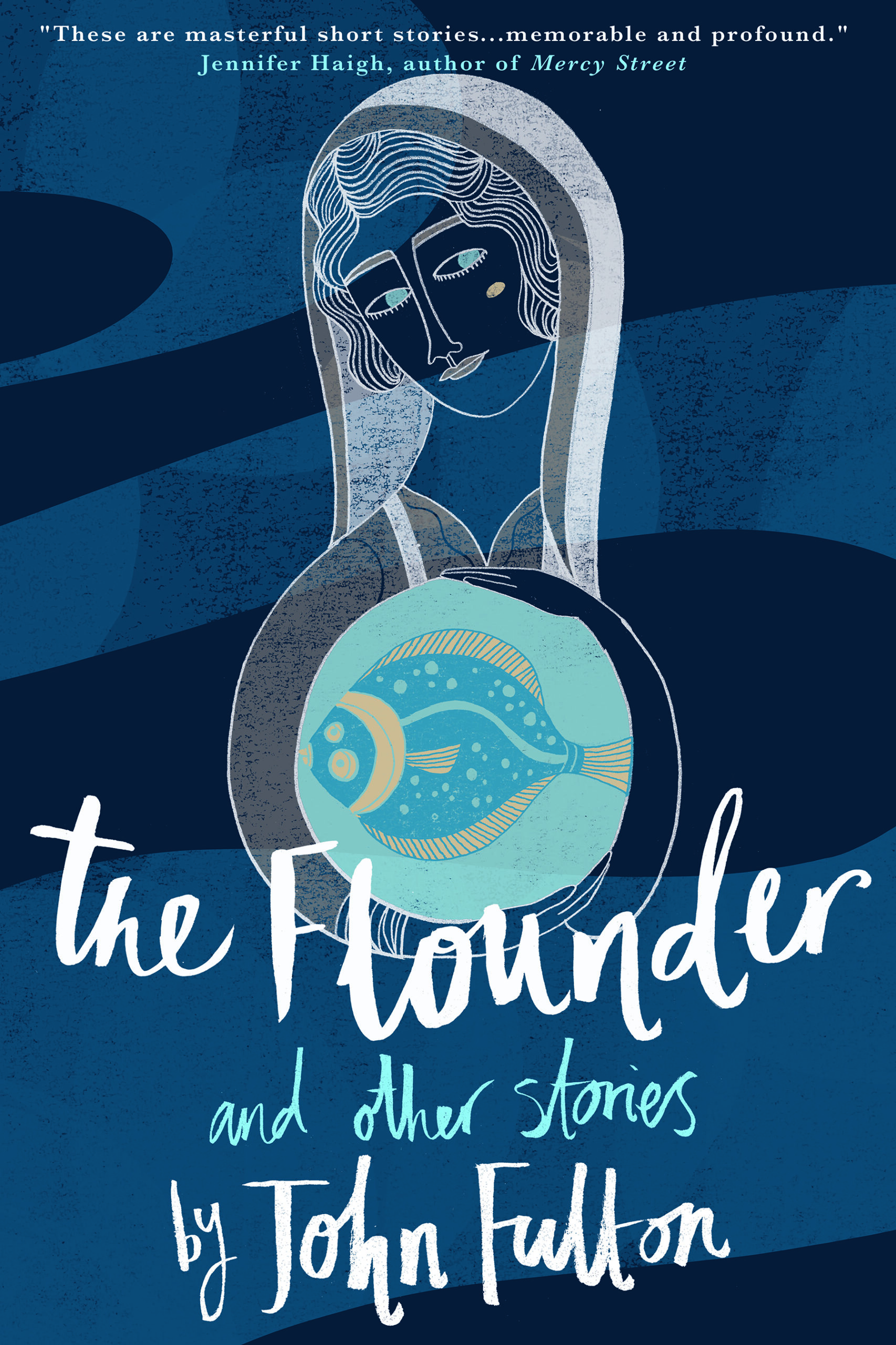
Q & A with John Fulton
JR: How did your first forays into writing compare to the work you publish now?
JF: It depends on what you mean by my “first forays,” which were way back in my college/university days. I was experimenting then, playing around with language, seeing what I could do, what sort of voices and linguistic acrobatics I was capable of. When I first started putting regular time in at the desk, it was the early 1990s and I was heavily influenced by Raymond Carver, Gabriel Garcia Marquez, Italo Calvino, and Angela Carter, among others. I was trying to write at once gritty realism and magical realism. That was a challenging combination to pull off, and it mostly didn’t succeed. It’s hard to write in the shadow of Marquez. Any attempt to sound/be like him will make the aspiring writer look small. But it was fun. Later, when I moved to continental Europe for four years, I was heavily under the spell of Gordon Lish, an influential editor who was big in the US. He was a proponent of an extreme kind of minimalism (a lot less is a whole lot more) and “dirty realism” or what some called “kitchen sink realism,” which means everyday life with some tough living thrown in: lots of alcohol, bad relationships, people living on the edge of poverty. He was the fiction editor of Esquire and then an important book editor at Vintage. He launched the careers of Raymond Carver, Barry Hannah, and Amy Hempel. My first published story was in a magazine Lish edited called The Quarterly.
Ultimately, that kind of writing, in which everything was implied and shown and almost nothing was said, left me feeling gagged and bound. Most of my stuff was no longer than 2-4 pages. I was living in Berlin, Germany, at that point, learning German and reading a lot in that language, including the original versions of The Brothers Grimms’ fairy tales, which are astonishingly good and nothing like the Disney versions I’d grown up with. That left me wanting to write even more in a fable-like mode, which often didn’t work for me.
It wasn’t until I moved back to the States to attend the University of Michigan MFA program that I broke free of that sort of writing. I discovered the stories of early Richard Ford, Alice Munro, Denis Johnson, and Joy Williams, and started writing longer form stories in the tradition of psychological realism. The writing I did in that program and for a few years after finishing at Michigan made it into my first collection. I was writing stories that cut immediately to conflict and veered towards crisis and more explosive material. For example, in one story, a janitor who works at the local YMCA gets drunk, puts too many chemicals in the pool, and thinks he’s blinded a little girl who jumps into the toxic water. He loses his job, goes home, drinks some more, fights with his wife, and struggles to rid himself of the terrible guilt he feels. There was humor in these stories, edgy writing, and often extreme events. I was also writing a lot about adolescent characters, whom I still find fascinating. Adolescents are natural rebels and sharp critics of the adult world even while childhood and innocence have become embarrassing—a source of shame for them. They’re stuck between worlds with nowhere to go. The title story in my first collection, “Retribution,” is about a 15-year-old girl whose mother is slowly dying. She’s angry, confused, has a deep infatuation with a German exchange student, and ends up intentionally hurting her driver’s education instructor. But there was a quietness in that story, a patience, that was new to me. This story was about fifty pages, the longest I’d ever written. In short, it suggested new directions, new possibilities for my work.
My current stories now are less conflict based, often less explosive and crises oriented, though there’s still a fair amount of tension in them. “Box of Watches” unfolds around an armed robbery in a pawnshop; “The Flounder” is about a couple struggling with an episode of infidelity that the wife confesses to her husband, the night before they leave their home in Switzerland for a vacation in France. But the stories take their time, they expand and explore character and situation over more pages than my earlier work. While I still like to write about adolescents, young characters take up fewer pages in The Flounder. I’m in my fifties now and am writing more about the relationship between generations, the young and the elderly. In fact, it wasn’t until I started reading the proofs for this book that I realized just how interested my more recent stories are in older characters who are aware of being close to the end of life, who remember and recall more than they look forward. My influences have changed, too. One of my favorite writers more recently is the great Irish novelist and short story writer, William Trevor. There’s a quiet tension in his work that is breathtaking, odd, and deeply unique to him. His stories develop with patience and move towards climaxes that can feel both muted and incredibly powerful.
In The Flounder, I’m also writing about a time in my life when I lived in Europe, mostly in Switzerland and Berlin, Germany, for four years. This was a challenging, if rewarding, experience. I was in my mid-twenties, in my first serious relationship, which was difficult and finally didn’t work out, and very aware of being American. For years, I tried to write about this time without much success. Then, in 2019-2020, I moved to France for a year with my family and the stories about this era in my life, which was a time of travel, mobility, and discovery, started to flow just as lockdown began in March of 2020. Something about being shut into a room and not being able to circulate freely gave rise to and access to that material. A lot of these stories were written or begun in lockdown. One thing I’ve learned about myself is that I often need many years, even a decade or more, to write about a formative experience.
JR: And if you had to recommend one Brothers Grimm tale?
JF: We all know these tales through Disney, which sanitized them. But the Grimms’ versions are brutal, violent, and graphic. I’d recommend dipping into one of the more familiar stories like “Cinderella.” We all think about this as a girl-meets-prince-charming story, which it is. But the reader hardly notices the happy ending here because it’s proceeded by such extreme abjection (a young girl’s beloved mother dies suddenly, after which her father quickly marries a sadistic, materialistic woman whose daughters torture and enslave Cinderella. This young girl not only works constantly but is fed sparingly from leftovers and kept like a farm animal. My favorite part is the revenge exacted on the stepsisters, who are so desperate to catch the prince that they carve large parts of their feet off (a big toe and a heel) to fit into the slipper. Their mother actually hands the knife to them and assures them that they won’t really need to walk once they’re the princess. The shoe fits, but soon enough the prince can see blood gushing from it and he’s not fooled.
By the way, a number of European fairy tales and folktales snuck their way into the stories in The Flounder (“Hansel and Gretel” in “Saved,” “The Fisherman and His Wife” in the title story, and “The Death and the Maiden” in “Budapest”). Perhaps this should come as no surprise since I was reading them during my years abroad and have been obsessed with them ever since. While I my stories are realistic, these tales, which contain surprising insight about human desire, sexuality, and greed, infuse the work in places with a bit of strange magic. At least, that’s my hope.
JR: You’ve discussed the gradual shift in style and subject matter. But are there any eurekamoments you can recall, moments that altered how you approach the task of writing? Or has it always been a gradual enterprise?
JF: I wish there were. I’ve heard many writers say—and I’ll concur with them—that every project feels as difficult and challenging as the first successful story or novel. The challenges of any given project are often unique and require new ways of thinking, new strategies, new solutions. That said, discovering material (what it is that one needs to write about) can liberate my work for a period of months or years until I’ve written through or reached the end of that material. I’ve also learned over the years that part of my process is arriving at impasses, places where the work just stops. When this happens, I usually need to do one of two things: work in a different direction or—and this is wretchedly hard for me to do—give up on the project. Forcing a story or novel is about the worst feeling I’ve encountered at the desk. There’s wisdom in knowing when to put something away. I do this a lot only to return, look at the pages with fresh eyes, and see something that I couldn’t see before and that allows me to finish the thing and often publish it.
Here’s one illustrative example: I began writing “Box of Watches,” which is included in The Flounder, more than 20 years ago. In 2017, I recalled that material—the pawnshop, the armed robbery, the grandfather—and felt the pull it still had on me. When I dug a very rough and incomplete draft of the story out of a box, I knew what to do with it and finished the story in a few days. There might be some “eureka” in that: know when to quit; know when to start again.
JR: For the most part the stories you tell in The Flounder are rooted in reality. Strange things happen – an imagined Charles Manson lurks in the shadows of “The Boy and the Murderer”; in “Box of Watches”, a gunman enters a pawnshop carrying a “box of used-up time.” But you seem to seek out the absurdities present in everyday life, rather than setting your fiction in worlds with different rules. What do you make of this interpretation? Are you ever tempted––and I had written this question even before you mentioned Marquez and Calvino!––are you ever tempted to take a step further in that direction, towards the speculative or the surreal? Or is the real world strange enough?
JF: I think you’re right: I work from the familiar towards the strange. And yes, as I say above, I’ve deeply admired authors like Marquez and Calvino, who work in the opposite direction: they need to ground their magical and/or absurd visions in the familiar or everyday world so that the reader sees its relevance and relatedness to lived experience. An old man with wings falls out of the sky (Marquez) or a man spends his entire life living in trees (Calvino). That’s wonderful, a kind of circus mirror that shows us what we often forget: how strange humanity really is. I think a lot of art does that. It delivers or returns us to a vision of awe and wonder at human experience—something we forget because we’re beaten down by routine, money making, survival, and the fatigue of being sensory creatures. We’d be overwhelmed if we really saw the variety and complexity of the world in front of us. There’s no time to really look at that bench at the bus stop or the tree next to it because you’ve got to get on the bus and get to the office.
But if you’re working in the realm of the familiar (otherwise known as “realism”), you need to find ways to show the reader why that bench and tree deserve and reward a closer look and might even remind us of the awe and strangeness that we’ve forgotten and that is everywhere around us. My mentor in graduate school, Charles Baxter, writes a wonderful essay about this called “On Defamiliarization.” Baxter talks about various strategies that writers employ to compel the reader to pay closer attention, to observe and see more carefully.
In many of the stories in The Flounder, there’s a kind of trap door that opens into a slightly strange or dreamlike vision, usually somewhere towards the middle. This transition is enabled by syntax, tone, and diction. One example: In the title story, Marian confesses to her husband Daniel that she’s just slept with someone else the night before they go on a short vacation. This isn’t exactly a new story: writers have been interested in infidelity for centuries. There is both tension and stakes in it. There’s also the challenge of showing the reader something unexpected about this particular couple and their struggle with a familiar problem. When they leave their home in Switzerland (what nation is more grounded in the stuff of everyday life—money, jobs, security, and routine—than this one?) and cross the border into France (a clear counterpoint to Switzerland), things change. A huge storm engulfs them. They arrive wet, frightened, and in the dark at their hotel, where they’re the only guests. Of course, the reader will recognize these elements. We’re in the realm of the gothic, the slightly scary, the fever dream. The hotel keepers are a long and happily married couple, and when the woman greets our troubled young Americans at the reception desk, her clothing is askew and there’s something at once pragmatic and sensual about her. She promises the couple a dinner in the hotel dining room with a delicious and magical fish as the main course. The meal they share is no ordinary meal and soon we’re in the realm of something like a dark fairy tale or folktale that’s real but slightly underlit, strange, full of desire, fear, and expectancy. As I say above, this particular story is informed by “The Fisherman and his Wife,” which concerns the dangers of wish fulfilment.
By the way, marriage is one institution that is easily destroyed by those who refuse (or are simply too tired) to remain attentive to the wonder around or in front of them—usually the wonder of their partner, whom they think they know. Could art save marriages? Probably not. But you might give it a try by reading The Flounder. How’s that for a sales pitch?
JR: Excellent, I’ll alert all my friends in bad marriages! Now, before publishing The Flounder with Blackwater, you published two other collections, The Animal Girl (LSU), Retribution (Picador), and the novel More Than Enough (Picador). Why do you seem to lean towards the short story as a form?
JF: For whatever reason, the form of the story is more intuitive to me. Perhaps I’m better at compression than expansion. I also like the way stories use implication, expressive absences and silence. What’s not on the page can be just as important and expressive as what it is on the page. Novels do this, too. But a short story, by its nature, almost necessarily does it.
I’m also dyslexic, which makes many things challenging for me, including the English language. I have issues with spacial relations and easily get lost, even in my own city of Boston. The novel can feel vast and my process of writing one often involves charts, outlines, sticky notes, drawings, and various other methods of reminding myself of what came before so that I can see what might come next. On the other hand, the story fits more easily in my mind as a unity. As a reader, I love both short fiction and novels. But there is a uniquely intense and immediate pleasure in reading a story in one sitting that just isn’t possible with the novel. Finally, the psychic toll of writing a novel is considerable. The great short story writer Lorrie Moore compares a story to a love affair and the novel to a long, hard marriage. As any practicing writer knows, there’s no guarantee that any project will succeed. I’ve published one novel but have begun many more and have two full drafts of two different novels in the drawer. I’ve also written or begun countless unsuccessful short stories. A failed short story may sting for a day or two or even week, after which you regroup and start another one.
JR: You’ve touched on how the stories in The Flounder are set across several countries: America, France, Hungary, Switzerland. Tell us a little bit about that, and about how you find the setting for each story?
JF: As I say above, I lived in continental Europe for four years in the early 1990s, which was an intense time for me. I learned a new language, was living in a new culture, and was reflective and self-conscious about what it meant to be American in an increasingly global, shrinking, and complex world. That was thirty years ago. The material resisted narrative fiction until the pandemic started and I was living in Europe again. The first story I completed about this time in my life was “Budapest,” about a Mormon kid from rural Utah discovering Eastern Europe shortly after the Berlin wall falls. He’s trying to escape from his own conservative and restrictive background just as the city dwellers around him are beginning to enjoy their own newfound freedom.
While I’m not a Mormon, I did grow up in the rural western United States, which is often defined by conservative religion and conservative values. It’s also an immense place and not easy to escape, which was one of the reasons I decided to leave it. I was aware of and reading many writers who’d felt that they had to leave their homeplaces to do their work: Henry James, Ernest Hemingway, James Joyce, T.S. Eliot, Gertrude Stein, and many more. “Budapest” is very much about this: leaving cultural and familial ideas of the self behind and seeing whatever you might see once these are gone or exposed for what they are. Of course, the character in “Budapest” also discovers that it’s almost impossible to escape the mythology of the United States, which I discovered, too. There’s a love-hate relationship the world has with the U.S. for good reasons. But it’s the adoration for the U.S. and its media culture that dogged me and that dogs the poor kid in “Budapest,” whom everyone recognizes immediately as American when he simply wants to fade away and lose this part of his identity. It turns out that it’s very hard to start over. Even Americans, who believe in the notion of self-making, have to live with history.
But I also write about the places I left. The story “Saved,” about two kids who befriend an elderly neighbor, takes place in the Mohave Desert in California, in a small town where I lived for a number of years as a kid. I know that town just as I know the Bible-belting church where the two kids go every Sunday. There’s a loneliness to that landscape that I absorbed and that, I hope, becomes expressive in the story. All the other places in The Flounder—Chicago, Boston, Normandy, Switzerland, Budapest—are places I spent time in or even lived in. I feel the same way about setting, a home or a room or a store or a hotel. Knowing the layout of rooms can help me make a setting feel real and fully evoked on the page. While I’ve never been robbed in a pawnshop, my grandfather used to own one. As a kid I spent a lot of Saturday afternoons with him behind the counter. He’d been robbed many times and he told stories about it. He died decades ago, but I hope I captured something about him in “Box of Watches.”
JR: The names in The Flounder are interesting. Daren and Martine in “Lovers.” Daniel and Marian in “Nocturne” and “The Flounder.” There’s something unsettling about it.
JF: Names are deeply personal and, I think, magical. They literally summon or call forth a person. That’s why we often say them. While some people know why they choose certain names for their children—i.e., their namesakes are beloved friends or relatives—often one is attracted to the sound, the impression, something mysterious in the cadence or syllables that, for whatever reason, seems right. If the name of a character doesn’t fit, I feel distracted by that and tend to grind to a halt until I find the name that works. I really can’t say why those characters ended up being Daren and Martine, Daniel and Marian. Martine, I knew, was from a French-speaking culture and I like the sound of that short, sweet “i” in the final syllable. I wonder if you’ve ever had a friend or acquaintance whose name just didn’t seem to fit them for whatever reason. There’s a cognitive dissonance when any given Frank, Jane, or Myrtle just doesn’t seem like a Frank, a Jane, or a Myrtle. What if Hamlet had been, I don’t know, Romeo or, to really stretch it, Frank…? There are so many great characters from literature—Holden Caufield, Huckleberry Finn, Julien Sorrel, Emma Bovary, Dorothea Brooke. To put it another way: character is spectral, hard to contain and embody, and names do just that—they hold and reflect character.
JR: That’s funny you mention that: sometimes I’m not sure the name John fits you! But perhaps that’s because it’s so close to home…
JS: Yes, I’d say the same about you. Of course, our name suffers from overuse. There are so many Johns out there that we’re in danger of being seen as part of a generic group. So perhaps we’re both too unique for our name?
JR: There are various themes that crop up in this collection and in your work generally, some of which we’ve mentioned. Nicholas Delbanco wrote on The Flounder: “Marital fidelity and infidelity are at issue here, as is the relation between generations and the search for (one might as well call it) authenticity.” One could say the collection also comments on love and loss, old age, poverty and wealth. How much does an author choose what they write about? Is it a conscious decision to have these themes reappear in your writing?
JS: Many years ago, the novelist Alice McDermott read a few chapters of a project I was working on and suggested a different direction. I started to explain what I wanted to do with the project and she said, with some vehemence, “Forget about what you want to do. You don’t choose your material. Your material chooses you.” I think the reason her words have stayed with me is that, in my experience, they’re true. I don’t think too much about theme or what my work is about. I think about character, about development (I don’t want to be repetitive), about surprising the reader and myself, creating tension, syntax, diction, tone, and avoiding cliché. But my material tends to be whatever bothers me, eats away at me, nags at me, and begs to be told or given expression to. There’s often a silence or void at the center of the thing I’m working on—something that needs to be said and that maybe can’t fully be said or explained—that tends to gain force as I work, that pulls words out and around it and suggests the next word or phrase or scene. That’s when I’m in what I’ve heard a lot of people call the “zone.” You don’t want to get in your way then by overthinking a story. You follow your gut. You keep going.
JR: Do you have a favourite character in The Flounder?
JF: I hesitate to admit that I do have a favorite character, but I think I do. It would be Kent Boyd in the story “What Kent Boyd Had.” I grew up with a lot of men like him. He’s cocky, loud, masculine, lacking in emotional intelligence, and more oblivious to those around him than he should be. While I probably wouldn’t want to have a beer with him, I think that I succeed (I hope I do) in making him sympathetic. I put incomplete versions of that story away for weeks and months only to take it out again and find it interesting. I kept seeing different sides of him and learning more about him as I worked. That’s what kept the story going for me and, I hope, what will make him and his story interesting and moving to readers. He’s as vulnerable as he is blustery. While he makes stupid mistakes, they reveal flaws and needs that give him dimension, depth, and, I hope, humanity.
JR: Let’s zoom in a little: what makes a good sentence to you? By and large, your writing feels quite measured, composed – it doesn’t seem as though there’s any rush to get this story out. How do you see the relationship between plot and language?
JF: Great question. I like surprises in my sentences, something jolting, a small explosion, a word or phrase that shimmers just a bit. Of course, there are different variants or degrees of stylized prose. Some writers veer towards transparency (I mostly do) and others toward linguistic pyrotechnics. Both are great if done well. One stylist I’ve appreciated over the years is the English novelist Martin Amis, whom we just lost recently. Here are some great sentences of his on the art of novel writing: “The trouble with life (the novelist will feel) is its amorphousness, its ridiculous fluidity. Look at it: thinly plotted, largely themeless, sentimental and ineluctably trite. The dialogue is poor, or at least violently uneven. The twists are either predictable or sensationalistic. And it’s always the same beginning, and the same ending.” There’s so much intelligence and wit in this prose. Who else would use a phrase like “ineluctably trite” or “violently uneven”? And the way he describes “life” from the novelist’s point of few is brilliantly defamiliarizing. He says nothing we don’t already know about the subject. But he says it in a way that makes what we know new to us.
As for the relationship between plot and language, I think this is mostly contained in the prose rhythms, in syntax and diction. Plot isn’t that interesting, though it does create tension and stakes, and it should rise organically out of the language. When I’m writing, I pay close attention to each word or phrase I put down because these suggest the next word or phrase. The cadence of the opening sentences to “Box of Watches” is explosive. We sense that we’re in the middle of a hold up before we see the gun. On the other hand, the opening sentences to “Budapest” are quieter, the rhythms contain an expectancy but not violence. We’re not surprised to feel and see that this story about a voyage is finally a romance and concerns a developing intimacy and connection between two people who meet on a train and spend the next few days together in a city that is strange to them.
JR: 100 words, biggest influences?
JF: You can’t escape your background, your religion (even if you lose your faith), your childhood, the landscape you grew up in (the western US), and then the choices you make as an adult, which involve where you live and what you do. All that is in my fiction. The writers who shape me change every year. But here are some: early Denis Johnson, Gabriel Garcia Marquez, early Richard Ford, William Trevor, the wacky and brilliant Joy Williams, Tim O’Brien, the sentences of Richard Brautigan, and often the last really good story collection or novel that I’ve read.
JR: Finally, you teach in the MFA writing programme at University of Massachusetts Boston. How do you enjoy teaching? Is it helpful for your writing?
JF: I love teaching, especially when the writing isn’t flowing. I have a ready-made community of like-minded folks among my colleagues and students, all of whom care about literature, reading, and writing. That’s invaluable in a culture that is often indifferent towards art. But teaching is a full-time job and tends to require most of my energy when I’m doing it. While I can get some work done during the academic year, it can be a struggle. Even if I have the time to work, the energy can be lacking. I do a lot of my writing during breaks and during the summers. It’s a gift to be on an academic schedule, which allows for long periods of concentrated work. Otherwise, seeing my students develop as writers and publish their work is exciting. I love that. It can prod me on to the next project, the next unforeseen story or novel.
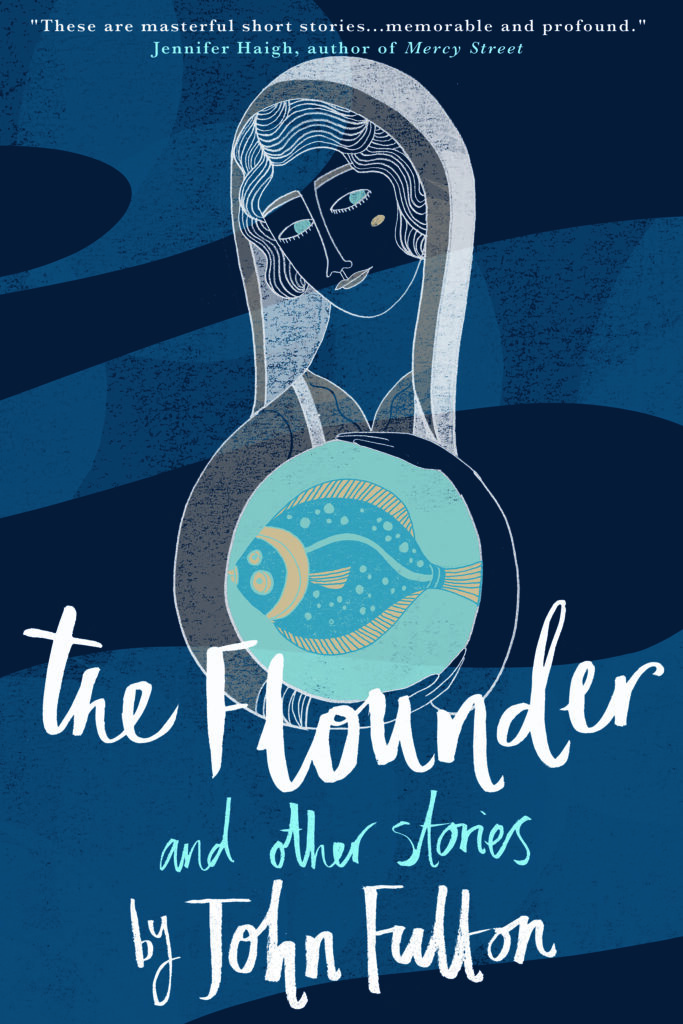
The Flounder
The riddles of desire, youth, old age, poverty, and wealth are laid bare in this radiant collection from a master of the form. From inner-city pawnshops to high-powered law firms, from the desert of California to the coast of France, The Flounder paints a vivid portrait of how complex and poignant everyday life can be. Told in vibrant, incantatory prose, these moving, lyrical, and surprising stories teeter between desperation and hope, with Fulton showing us what lasts in an impermanent world.
$9.99 – $22.99Toxic Positivity Afloat: a Modern-Day retelling of Hemingway’s The Old Man and The Sea
Toxic positivity is running amok, and not even Hemingway’s Santiago can reel it in. Then again, reeling it in would be the antithesis to Santiago’s indestructible pride just as it would be to a large percentage of humanity whose hold is as relentless as the old man’s. Some would label it a conundrum; others, a paradox. And both would be challenged. Destruction is a much better word choice. And yet even if Santiago could turn back the clock, his toxic positivity (i.e., his unshakeable perseverance and determination) would prevent him from charting a different course. Santiago would, most assuredly, resist even the known dangers that led to his eventual downfall.
Toxic positivity brings with it a level of denial and minimization of such dire consequences that is reminiscent of the inevitability Santiago encounters as he attempts to bring in his giant marlin, knowing full well that the sharks are gathering. And yet, he takes pride in pressing on. He denies that one plus one equals—will always equal—two. Toxic positivity would argue otherwise, even with the facts clearly stacked.
Even as Santiago encountered one defeat after another, both from the uncertain and incalculable seas to his physical and mental exhaustion, he held tightest not to the pain from the skiff’s ropes, but to his own toxic positivity. And if Santiago were to magically appear among us in 2023, he would be welcomed with opened arms by throngs of those who have also become drunk on the sugary concoction that they gulp by the gallons. Metaphorically, this modern-day retelling represents toxic positivity through Santiago’s unnerving denial as those of us who become its victims struggle, much like the marlin, to remain afloat in turbulent seas that circle us like the unwelcomed sharks, knowing full well the outcome. Donning a falsely-positive façade leads nowhere except a manic search for an abundance of fig leaves. In the end, our fate, like Santiago’s is sealed, leaving toxic positivity like a thin, barely-visible layer of ice covering depths of the sea that we do not wish to traverse, however lightly. Toxic positivity’s first cousin, avoidance, has nowhere safe to rest its weary body.
Oh how I wish Santiago’s fragile feelings of doubt and grief and aloneness could have been shouted to the rooftops, soaring into the gathering clouds, where he could absorb the rushing storms to then gaze upon the emerging sun. Shaming and guilt and failure be damned. Unfortunately, Santiago does not recognize his own self-inflicted cruelty, anymore than we do. That’s the real tragedy. “Santiago,” I would whisper, “it’s okay to not be okay.”
Kathleen M. Jacobs writes books for young readers. She holds an M. A. in Humanistic Studies, and lives in Charleston, West Virginia. She can be reached at www.kathleenmjacobs.com
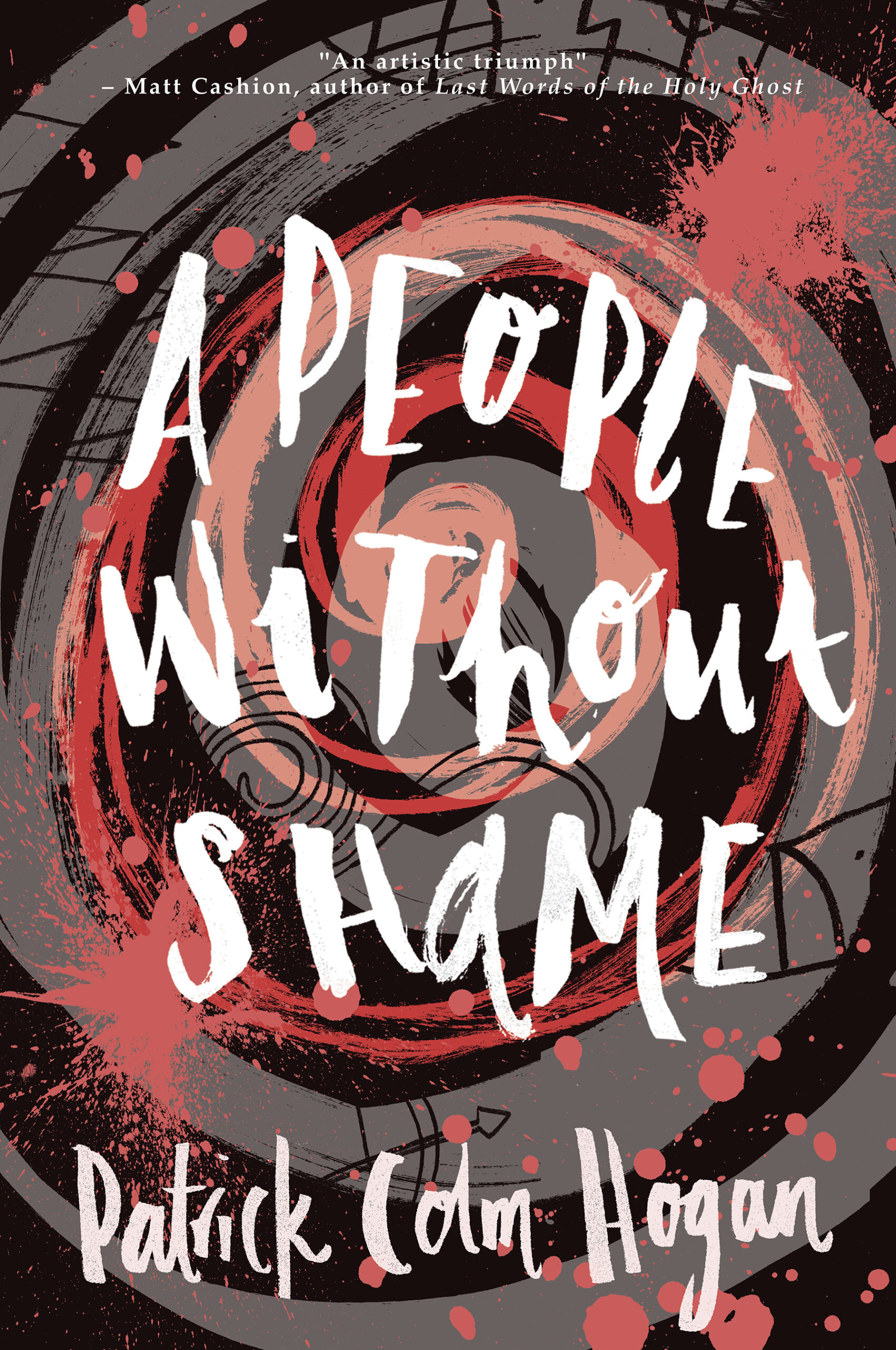
A Q&A with Patrick Colm Hogan
JR: A People Without Shame is a strange book, full of contrasting parts. At times diary, at times legend, at times transcript, at times article, it seems as though the novel is trying to demonstrate how difficult it is to convey its subject matter in a conventional manner. What do you think of this interpretation?
PCH: Yes, that seems to me right. I didn’t think of it in precisely those terms, but I agree. Perhaps surprisingly, I thought of it more from the reader’s side than from the author’s. Specifically, we are always given only diverse and fragmentary sources, with necessarily partial and to some degree biased construals of events. Then we have to figure out what happened, relying on somewhat opaque and surprisingly malleable testimonies of limited reliability. Actually, this is the case even from the author’s perspective, and even if the work is itself testimonial. Specifically, empirical research has shown that our memories of events alter with the circumstances in which they are recalled. In that sense, even someone who experienced the actual events has to puzzle out—as if from blurry photographs and recordings distorted by static––what really happened.
JR: Yes, with several of the events mentioned in the book there is no way to truly know what happened, due to the opacity, and due to bias and misinformation. It’s nice that we don’t see that anymore these days, isn’t it?
PCH: Despite the ellipses, problematic chains of transmission, etc., I actually think we end up with a pretty solid idea of most major events in the novel (though, as you say, there are some that remain bewildering). For example, our initial information about Songari prisons is basically hearsay. But when A. ends up in a Songari cell, there are enough confirmatory details to indicate that the “hearsay” is well-founded. Also, A. is not omniscient and he does have biases (like everybody). But, in my view, he merits our trust in both his general competence and good intentions. Sometimes a postmodern writer will suggest that we cannot ever really get at the truth (or, what is more extreme, that maybe there is no such thing as the truth). I wanted to indicate that, despite difficulties, this is not the case. Most often, we can get a good idea of the truth—though, in evaluating the evidence, alternative explanations, and so on, we need to be aware of the very serious problems we face (again, even with our own personal experiences).
JR: You have dedicated much of your life to studying colonialism, and until now have chiefly written scholarly non-fiction on the subject (as well as many others). After authoring over twenty academic books, what motivated you to take the plunge into fiction?
PCH: Actually, things happened in the opposite direction. I was writing poetry from 7th grade on. In 1972, as a freshman in high school, I won a poetry contest in Kansas City, announced at an event which featured a reading by Mona van Duyn (later to become a poet laureate of the United States) and earning myself the royal sum of $25 (apparently equivalent to $181.44 today). It is worth noting that it was an anti-war poem (A People Without Shame is, perhaps before all else, an anti-war novel). Twenty-five years later, perhaps unconsciously emboldened by this early approbation, I wrote a book-length, narrative poem, based on Hindu goddess myths. I had no success in publishing it until 2014. While trying to publish that, I wrote and repeatedly revised A People Without Shame. I had much more success with scholarly writing, which led me to devote my time and effort to that. Even so, the two types of writing have remained inter-connected for me. For example, later this year, Routledge will publish my most recent scholarly book, What is Colonialism?, which derives in part from my work finishing up A People Without Shame for Blackwater. Indeed, the critical book in some ways (indirectly) explains what I am doing in the novel.
JR: And what did you spend your $25 on?
PCH: Probably LPs—The Who, Led Zeppelin, The Grateful Dead; the sorts of things other kids my age were buying. If I bought poetry, it would have been e. e. cummings.
JR: From where in particular did you draw your influences when you were creating Somota, and when penning the epic of Garuna that is woven through the book? When A. arrives and introduces us to it, it feels like a very real place.
PCH: Thanks. The sense of reality (insofar as people do indeed feel that) probably has two sources. First, the main characters and the things they do have sources in my own, biographical experiences. Though I re-imagine them in a very different context (something that our minds have evolved to do pretty well), I feel that the original motives, beliefs, rationalizations, and so forth, remain plausible in the new circumstances. Second, I have tried to push myself to give considerable detail, thereby making the places, events, and people more distinct and particular in the reader’s imagination (or “simulation,” as cognitive scientists would say). This tends to foster a sense of reality in part by fostering an emotional response.
As to influences, those are of two types—historical and literary––which also (I hope) contribute to the sense of reality. As to the former, I have sought to base most of the particular occurrences in the novel on historical precedents. Examples range from the missing generation of Somotan men (derived from the radical reduction in men of the draftee generation in the U.S.S.R., due to German colonialism), to the preoccupation with hunger (due to a range of colonial policies that have consistently rendered colonized societies food insecure), to the nature of the conquest of Somota (which is modelled on the conquest of Igboland), to some aspects of the insurgency (which are based on actions of the Kenya Land and Freedom Army). More complex structures also have historical sources. For example, the broad organization of the region by reference to the northern Songari, the south-western Kelans, and the south-eastern Somotans is modelled on Nigeria, with the Hausa-Fulani to the north, the Yoruba to the south-west, and the Igbo to the south-east.
As to the literary sources, people will probably remark most readily on the use of the Mahabharata in The Dream of Garuna, with the five ruling brothers, the disenfranchised eldest brother, and so on. But I draw almost as much on Exodus, with the abandonment of Garuna in the river to his leading his people out of the land of their bondage. I draw also on a range of myths ranging from the puranas of India to the oral tales of the Americas, sometimes as recounted in Levi-Strauss’s magisterial multi-volume Mythologiques. I was surprised to be reminded of the relevance of the story of Sin and Death, when I had to re-read Paradise Lost recently. When I listened to an audiobook of Vergil, I was also surprised to see the recurring influence of the Aeneid on the treatment of war in the novel. There are no doubt many other, forgotten influences of this sort. Modern works have of course had an impact as well. I have often emphasized Coetzee’s Waiting for the Barbarians. Joyce’s Ulysses is a more subtle, but pervasive presence.
JR: In saying you pushed yourself to give considerable detail so as to foster a sense of reality in the reader’s imagination by fostering an emotional response, you make storytelling sound quite formulaic. Is it?
PCH: Well, it is in part formulaic. I’ve argued (in, for example, What Literature Teaches Us About Emotion) that emotional elicitors are not a matter of broad evaluation, but of concrete perception or imagination. That has partially formulaic consequences, but only partially. Here’s a simple example. Someone might write a story about a first date, including the statement, “We went to a restaurant and had something to eat.” For a particular story, this might be the most appropriate thing to write. But it would probably be better to develop some details in the vast majority of cases. Contrast the preceding, generic statement with deciding to forego the restaurant when the two of you see a popsicle stand, then—on reading the available flavors––puzzle over just what is a boysenberry is, or the two of you go to the restaurant, but end up only sharing a dessert, due to the scandalous prices. There isn’t a single right way of doing this for every story, and sometimes writers will make disruptive blunders in trying to be particular, thereby breaking the emotional continuity of the piece and undermining the effect. But, for the most part, such particularity is, I believe, more likely to foster engagement, emotional response, and a sense of reality.
JR: Kehinta is a compelling character. How would you describe her to those who haven’t read the book?
PCH: She is the Somotan bard in charge of preserving the main oral epic and of refashioning it to serve the social and political needs of her society. But, like other Somotans, she also does manual labor—fishing, when she is in a traditional, Somotan community. Unlike our stereotype of a poet, or our gender stereotypes, she is not at all romantic. She works with A, not for the wonders of poetry—still less from some exaggerated respect for Europeans in general or A. in particular––but for the medical supplies he arranges in payment. She has a pragmatic, non-moral response to sexuality (though, of course, she despises force or coercion in sexual relations). On the other hand, she is almost certainly more vulnerable than she appears. That discrepancy is mainly due to the fact that she hardly ever shows weakness. Like a traditional Igbo man (such as Okonkwo in Achebe’s Things Fall Apart), she will fairly readily express anger, but only hints at sorrow or fear. Those moments come, for example, when she alludes to her husband’s death, or when she becomes concerned, however briefly, that A. has set her up to be an informant. This isn’t a cultural trait, by the way, but an individual trait. For example, the other woman who is assaulted in the novel reacts with great fear and sorrow.
JR: For how long had the novel been in the works? Did any particular parts come first?
PCH: About 25 years. At this distance, I can’t recall what I wrote first and what came after. I do remember that I did a lot of “scholarly” background work to guide the writing. For example, I outlined out some principles of the Somotan and Kelan languages (both imagined as Indo-European languages) in contrast with Songari (a Semitic language). I also sketched a more detailed geography. I don’t know where any of those notes might be now; I probably discarded them.
JR: We must discuss your protagonist A., and the difficult themes the book addresses. A. often laments that he is in a painful position. He is keenly aware of his status as part of the colonial regime, disparaging of the Reverend G. and the government’s mission, and frequently faces discrimination himself. Yet, he is simultaneously too afraid to do much of anything about the injustices surrounding him. And of course, when compared to the people of Somota, who face the destruction of their culture and the massacre of their communities before his eyes, the reader is keenly aware that he is really not in such a painful position at all. What do you think of A.? Do you like him? He doesn’t seem to like himself very much.
PCH: Somotan traditions (in the novel) suggest that the more ethically sensitive one is, thus the more moral one is, the more keenly one is conscious of one’s sinfulness. I think A. is a very humane character and he does act with genuine moral courage. But he is deeply aware of just how little he has tried to do, the times when he has not tried to do anything at all (as in the case of the Kelan weavers), and how ineffective he has been even when he has tried to do something. His first problem is that he is naïve. But he is open to learning and does learn, if incompletely. Moreover, he does face real dangers. First, there is the possibility of continuing imprisonment, with all that suggests about his future. Then there are the implied dangers to Kehinta, suggested by G. It is also critically important that there is no clear social context in which he can join with others in shared anti-colonial work. Such a context is necessary if anyone is going to accomplish anything positive, whether against colonialism or any other social harm.
JR: And a comment on the discrimination A. himself faces. He is Jewish, and Irish, among predominantly English fellows – correct? What motivated this character background?
PCH: Well, the Irish part is me. (I did one of those genetic tests a couple of years ago and it claimed that something like 90% of my genetic ancestors came from Clare or Cork; evidently, we didn’t travel much.) This allowed me to talk about the anti-colonialism in my extended family, basically just attributing it to A.’s background. The Jewish half is due in part to my mother’s repeated claim that, if she weren’t Catholic, she’d be Jewish. I briefly misunderstood this as a child, but soon came to realize that it was just her hyperbolic way of saying that she would never be a Protestant. Much more importantly, I wanted A. to have some more direct experience of personal discrimination. His Irish background gives him a connection with social poverty and the like, but he does not experience much personal discrimination, except perhaps from other Irish characters.
JR: Have you or will you ever write anything else based in Somota?
PCH: I had never thought about it, but on reading your question, I immediately thought that it would be possible to write a work about, say, two linguists, one Somotan, one European, who are working on the language in independent Kela; the European, upon reading A People Without Shame, begins to suspect that his colleague is Kehinta’s daughter. That would probably never be resolved. This story might be intercut with news reports or Kelan television ads, or something else rather different from the translations in A People Without Shame. I think it might work. But my health probably won’t allow me to undertake such a project.
JR: What books have you read that influenced how A People Without Shame has turned out?
PCH: I’ve already mentioned a number of them. I might add works on colonialism, especially in Southeast Asia and Central and South America. Indeed, though the colonialists in the novel are British, the concerns that drove the writing of the novel were far more about U.S. imperialism in, for example, Guatemala or Chile. (This reminds me that the novel is also influenced by cinema, such as Costa-Gavras’s Missing and Z.)
I should also add works on ethics, both various of Kant’s writings and work on dharma theory in Hindu tradition. A recurring theme in Somotan culture in the novel—a theme that I’m afraid might readily lend itself to misinterpretation—is that the moral quality of an act is not reflected in the benefits of its outcome for the agent. Somotan ethics is, so to speak, the diametric opposite of prosperity theology. For example, what happens to Kahngee in no way suggests that what she did was wrong.
JR: A word on the epic of Garuna, and the various other myths and folktales scattered throughout the book. How did you find the shift between writing in this style, and writing from the point of view of A.?
PCH: I have written fairly many imitations of different styles over the years. It wasn’t to train myself, but just for fun. A few were part of academic articles. They were sometimes imitations of chapter styles in Ulysses. They were sometimes other things—for example, Nabokov’s Pale Fire or the speech of some public figure, such as Joe Biden. As a result of this (inadvertent) practice, I found it easier to switch styles than it might have been otherwise.
JR: Finally, looking back on the book now, is there anything in there that surprises you, that you did not expect to feature in a book published with your name on it?
PCH: There are certainly things that would have surprised younger me. But I drafted the book long enough ago that what is there does not surprise me now. I am a bit surprised that I seem to have left out most of the embarrassing errors that were present in earlier versions. That is due, in part, to your careful readings, as well as those of Elizabeth and Vivien.
JR: Agreed, we deserve all the credit…
PCH: Actually, the three of you do deserve the credit of seeing value in the book, so that it has been “published with [my] name on it.”
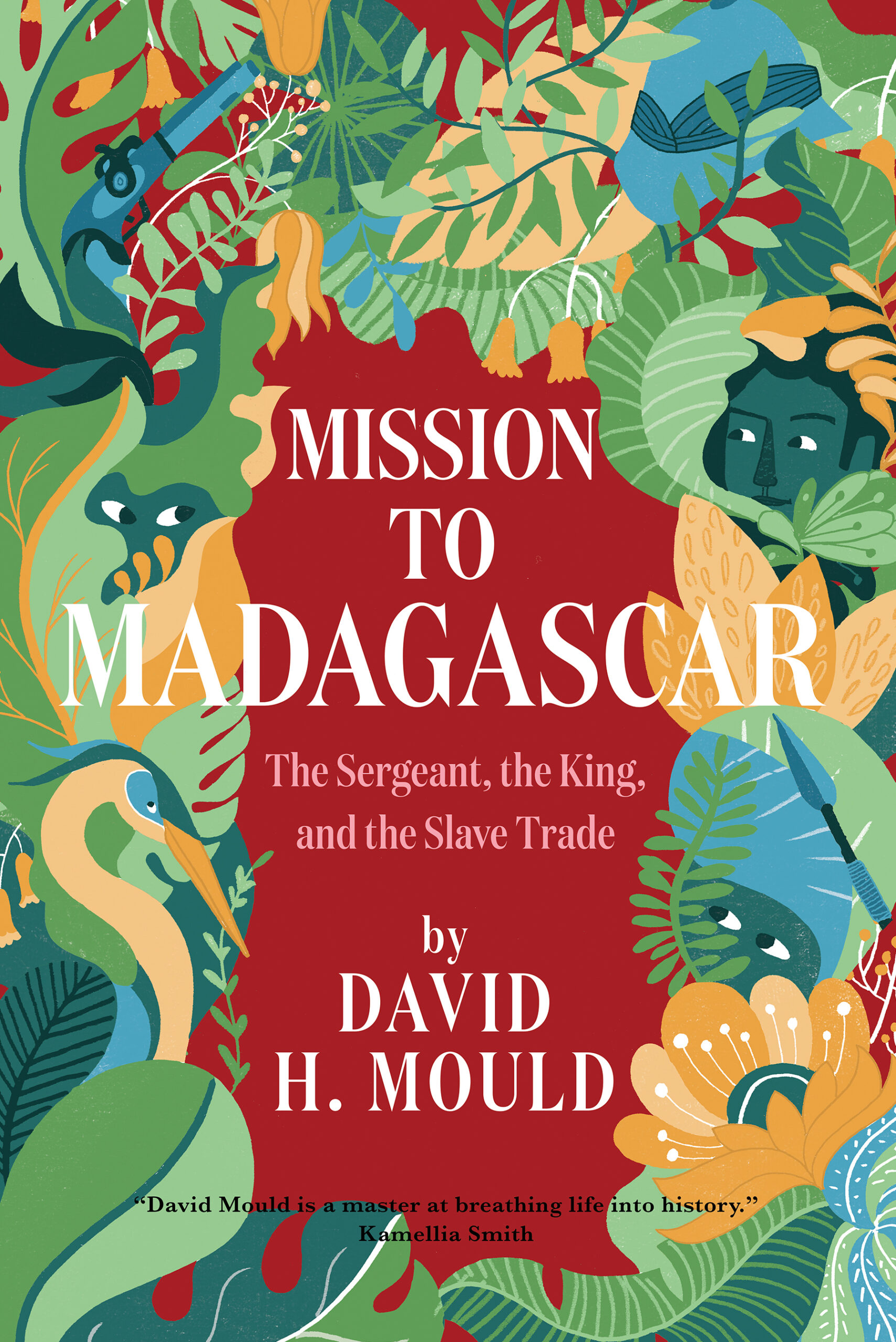
Mission to Madagascar: The Sergeant, the King, and the Slave Trade
by David H Mould
In 1817, a decade after Britain banned the slave trade to its colonies, a 30-year-old East India Company sergeant with no diplomatic training embarked on a risky mission. James Hastie travelled for almost a month from the coast of Madagascar through the tropical rainforest to the central highlands. His mission—to persuade Radama, the young and warlike ruler of the most powerful kingdom on the island, to stop the export of slaves.
Most studies of the slave trade focus on the transatlantic traffic to the United States, the Caribbean and South America. Yet for hundreds of years, a larger trade flourished in the Indian Ocean where Arab traders trafficked their human cargoes from East Africa to the slave markets of Arabia and India.
From Madagascar, slaves were smuggled to the plantations of Mauritius, seized by Britain from France during the Napoleonic Wars. Its governor, the subtle, silver-tongued Robert Townsend Farquhar, was in a tough position, under pressure from London to end the slave trade yet knowing that the island’s economy depended on slave labor. Without the ships to police the sea lanes, he decided that the best strategy was a diplomatic one—to form an alliance with the rising military power in Madagascar.
The relationship between Hastie and Radama would shape the course of history in the southwest Indian Ocean. Hastie lived by his wits as he won the king’s confidence. The intelligent, charming yet ruthless Radama skillfully used the British envoy to assert power over the nobility and his political rivals who profited from the slave trade.
The treaty they forged was a deal with the devil: in return for the slave trade ban, the British trained Radama’s army and supplied muskets and gunpowder, allowing the king to expand his dominions, while turning a blind eye to the internal slave trade. Hastie became the British agent in Madagascar, and a trusted advisor to Radama, accompanying him on his military campaigns and introducing social reforms, until his untimely death in 1826.
Mission to Madagascar is based on Hastie’s unpublished journals, one of them recently discovered, and other primary sources, including letters and political and military dispatches. The journals from 1817 to 1825, archived in Mauritius, London, and the U.S., weave a narrative of hazardous travel, byzantine court intrigue and colonial geopolitics, and offer the most comprehensive early 19th century account of Madagascar, its landscape, crops, industry, commerce, culture, and inhabitants.
David became fascinated by Madagascar’s history and culture after making five trips between 2014 and 2017 for a UNICEF research project. Unable to travel for more than two years because of COVID, he decided he wanted to tell someone else’s travel story. He describes his research on Hastie as “like a large jigsaw puzzle, where the pieces never exactly fit” but ultimately “a thrilling and rewarding historical journey.” This is the first biography of a man whom Sir Mervyn Brown, a former UK ambassador and historian of Madagascar, described as “one of the most important and attractive figures in the history of Anglo-Malagasy relations.”
On Writing
by Cameron Alam
Once upon a time, I thought historical fiction was written the way a house is built, brick by brick, word by word, the author using her mortar of craft to adhere words together into sentences, sentences into paragraphs, paragraphs into chapters as the story is formed. When I sat down to write my novel and thought I might find comfort building up a story from stacks of research, my actual experience was… uncomfortable. Those first bricks were heavy. With glistening brow I laid them down, used a level, repositioned them, made them straight, spread on mortar, added more. The work felt tedious. When I paused and stepped back to observe my early writing, what I saw was as dense as a brick wall.
I wasn’t the only one. When I handed my first chapter to a trusted friend, she returned after reading it and said, “I cried with joy, because you are writing your book!” And then she delivered the critique I had asked for. The scene felt compressed, condensed like a short story might be, as though I had bound my sentences together tight so as not to waste my readers’ time. “Waste our time!” she urged. “Allow your words to take up space.”
For a while after her observation, I soaked in hot baths in place of writing. I was intimidated by the thought of my words taking up space. During one of those contemplative baths, while I was lost in steam, I heard a voice. Not the voice of one of my children searching for me, nor my husband wondering when dinner would be ready. Another voice, just as palpable. I recognized it immediately, as though it belonged to a kindred spirit. It was the voice of my protagonist’s older brother. He wasn’t talking to me. He was simply talking…and on and on. I wondered if he had been waiting for someone all this time. Or if his words had been echoing in the ether over the past two centuries and in my meditative state I had picked up some obscure signal which allowed me to listen in. I wondered why it wasn’t her, my central character, the young woman I was aching to know, to better understand as I observed her through the obscuring mist of generations. Where was her voice? Was it as bound-up as mine? Whatever the reason for her silence, once I heard her brother’s voice, I could not unhear it. It filled me with wonder. And answers. Here was someone unapologetically willing to take up more than a little space with his own words.
When I took up my pen again and returned to writing with fervor, I knew historical fiction need not be written like a house is built. It need not begin ground-up from research, in a methodical fashion, brick by brick, cemented together for stability with no room for the author’s own voice. I felt considerably more like a sculptor or a whittler, considering a lump of clay or a piece of wood, than a builder. I could see the outline of the form hidden inside. I could hear it, thanks to my protagonist’s older brother. And once that hidden form was revealed to me, she finally revealed herself too, my protagonist, as though she had been waiting for that moment when I would push aside the sense of obligation to build brick by brick and lose all concern for wasted time. A writer’s words, my words, I learned through what she revealed to me, are the gift we are given to draw life from story.
Twenty Fingers for One Dollar
By Kate Mueser
“So, is it autobiographical?”
Those who know me well will ask that question when they read my debut novel, The Girl with Twenty Fingers, about an American used-to-be pianist in Germany who plays Mozart’s works for piano four hands with an elderly German man.
“Absolutely not!” I would reply.
“But Kate,” they would argue, “You also used to be a pianist and lived in Germany.”
“True,” I would have to concede. “But unlike Sarah, my protagonist, I never bombed a performance of Mozart’s D Minor Concerto. In fact, many years ago, I did play his C Major Concerto with an orchestra and had no major complaints from the audience.”
“But didn’t you once tell me about playing the piano with an elderly German?”
Ah yes. The initial inspiration for The Girl with Twenty Fingers was indeed rooted in reality, even if the book itself is fiction.
When I was twenty-two years old and moving back to Bonn from the US after spending several months there the previous year, I needed a place to stay temporarily while I looked for an apartment. Through the pastor of a local church, I was connected with an elderly couple at the far edge of town, whom I’ll call Herr and Frau S. The pastor knew I had a degree in piano performance, and the couple had a grand piano and an extra room. It was a perfect match.
I arrived late one January night, stepping out of the taxi with a large suitcase holding all of my belongings, jetlagged from the long flight. The winter chill felt inhospitable after my time in temperate California; the snow on the ground was not fluffy and picturesque but clumped in dirty, icy chunks. A pang of fear and regret struck me: Was I doing the right thing, coming back to this faraway place to start a life? Calling the taxi to take me straight back to the airport where I could catch the next flight home suddenly seemed a lot more appealing.
Thankfully, Herr and Frau S. welcomed me warmly, offered me a comfortable room upstairs, and insisted I share meals with them. Nevertheless, it seemed like there was an insurmountable gap between me and Herr S. in particular — not least the multiple generations that divided us. My German was not yet fluent; he was difficult to understand and acted gruff at times. I was a stranger in a country that was still strange to me.
It took a few days before my fingers thawed enough to try out the piano. While it was not nearly as spectacular as the Bechstein grand in my book, it was a sturdy instrument with a friendly sound.
“Mozart wrote many lovely works for piano four hands,” Herr S. said after I’d spent a few minutes coaxing contiguous notes out of my memory and the keyboard. “Perhaps you’d like to play a few together?”
I knew the Mozart sonatas for twenty fingers quite well; in high school I’d spent several summers at the San Francisco Conservatory working on them as part of their chamber music program for young musicians. As Herr S.’s houseguest, I couldn’t say no.
Our first attempts were awkward. Piano for four hands is an intimate and athletic undertaking. It’s not like playing with a clarinetist or cellist — someone who hides in the crook of the grand piano, someone with whom you share the occasional nod. Piano duets mean bumping bottoms and rubbing elbows; they require inhaling your partner’s aftershave while you overlap your hands to reach the opposite register. Mozart wrote those sonatas for himself and his sister: The two of them were conveniently small in stature and obviously well acquainted with each other. With Herr S., sitting side by side at his grand piano seemed decidedly less natural.
He was, I had deduced while living in his house, well over ninety. His fingers bore the stiffness of age, but he played remarkably well and was familiar with the repertoire. After a few Mozart sessions, his gruffness waned and it became apparent that he was deeply enjoying not just making music, but making it together. It must have been years since he had played with anyone.
What Herr S. didn’t know was that my relationship with music was complicated at the time. My plan to become a concert pianist had not panned out. The classical music world had demanded more than I was able to give and one degree did not suffice. I was angry at my instrument, and I didn’t know what to do with my life. (Yes, ok — admittedly not unlike my protagonist Sarah.)
At times, we would nail the brutal Mozartian runs and bring those piercing second movement melodies to sing. But there were also stumbles on the scales, the pianissimos that didn’t sound at all, the rests that were miscounted. For mistakes like those, I would have been yelled at at music school. With Herr S., there was plenty of grace. Experiencing his joy in the imperfect music we made was refreshing and healing.
After two weeks or so in the spare room upstairs, I signed a lease on an apartment a block away from the center of Bonn and was looking forward to getting out of the distant suburbs and into the city. Before I packed up my suitcase and stripped the bed, I asked Herr S. whether I could pay him for room and board. A fee hadn’t been part of the arrangement, but I didn’t want to commit any cultural faux pas.
“Yes,” he said, “Yes, you can.”
For a split second, I was concerned. Had I misunderstood something? Should I have paid in advance?
“It will cost you one American dollar,” he said stoically.
Relief! I was glad my language skills hadn’t failed me after all, but still unsure whether he was joking or serious. Fortunately, I still had a green dollar in my wallet, which was otherwise populated by colorful euro notes.
He accepted my dollar with a kind laugh and asked, almost bashfully, “Maybe you’d like to keep playing together?”
As so, for the following year, I hopped on the bus every two weeks for the long trek out to the edge of town. Frau S. baked a different cake each time and Herr S. and I would play Mozart until we were out of breath and then chat over coffee, creamer, and homemade dessert.
I never found out what Herr S. did during the Nazi period. Because he is not Otto Steinmann and I am not Sarah Johnson, Herr S. gave me no past to unravel. Instead, we talked about Bonn, that little city on the Rhine that played such a big role as a Cold War capital and reinvented itself after Reunification. About raising kids and not seeing grandkids often enough. About rising prices and the nice little bakery around the corner, the only one for kilometers.
My visits with Herr and Frau S. became for me a window — however unsettling — into the future: We all get older; we all eventually get old, as unimaginable as that was at twenty-two. Our meetings were also a window into a culture and a language that I was only beginning to get to know. Two people may not be a whole country, but each country is comprised of single souls. Now, twenty years later, I am married to a German and mother to three more and have since become more German than I’d ever planned to.
Most importantly, my friendship with Herr and Frau S. taught me to see music more simply. It could be something to casually share with others; neither was it confined to a practice cubicle nor was it worthless without a stage. Music could be a hobby that could last forever, well into old age. I did not have to become music’s eternally bitter divorcée at twenty-two. And maybe music and I didn’t have to become lovers at all. Maybe we could just stay friends. Forever, like Herr S.
After about a year of biweekly bus trips to the grand piano on the outskirts of Bonn, I started working more, picking up additional classes as an English teacher. I could no longer keep up the commitment. At the same time, Herr S.’s health declined. While we kept in touch, the Mozart scores were closed and shelved. It was time to move on.
When Herr S. passed away several years later, the pastor who’d brought us together asked me to play something at his funeral. I chose one of the Mozart sonatas for four hands that we had played together in his living room but performed only the primo part. The piece was half empty, void of its roots. The secondo solo bits were replaced with gaping holes. Sometimes silence speaks louder than music.
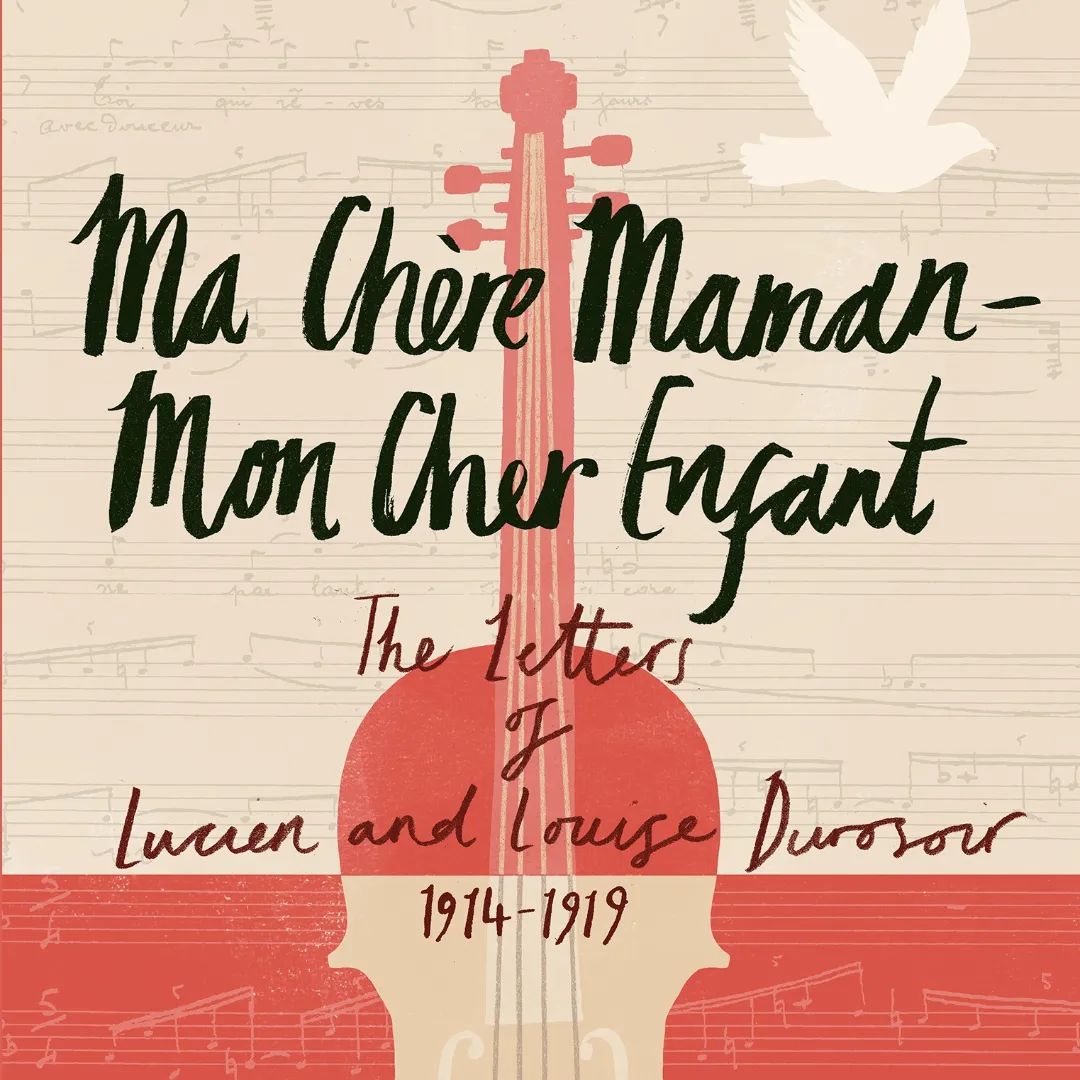
Ma Chère Maman—Mon Cher Enfant
What does French baroque music have to do with letters from World War I? The answer is not obvious but, in this case, one of simple coincidence. Two scholars of the French Baroque from both sides of the Atlantic become friends; finally, their spouses meet. The rest, as far as this book is concerned, is history. Luc Durosoir, the husband of the French scholar, told me about his retirement project—transcribing, editing, and publishing a collection of his father’s letters from World War One. I, the American spouse, was immediately taken by the unusual story of his father, Lucien Durosoir, a celebrated solo violinist, mobilized to fight the Germans at age 34, a sad twist of fate for a man who had lived in Germany, regularly visited Germany and Austria, spoke the language, and admired all aspects of German culture. His creation of a string quartet, working on and playing chamber music in the midst of the cataclysm of that war, was very far from the image I had of the war.
I eagerly started reading the collection of letters; long before I got to the part about the chamber music, I was pulled in by the early years of the war, by the enthusiasm and confidence of the French soldier (‘We’ll be home by the end of the year!’). Then by the stories of life in the trenches, and the way Lucien searched out whatever violin he could find and musicians to play with—in church, for the Red Cross, any reason to play was good enough for him. Translate the letters so my friends and family could read what I was reading—why not?
The baroque music connection turned out to be deeper than the original, chance encounter, although that was essential. Lucien became a composer after the war. He was trained in, and formed by, the music of baroque composers; his compositions are defined by his use of counterpoint, in a way unique to him, but clearly reminiscent of the baroque masters, most notably J.S. Bach. And then, surprise, my editor turns out to be a baroque flute player!
The French edition of selected letters was only the beginning of the adventure that led to Ma Chère Maman—Mon Cher Enfant. As the title suggests, there were more letters, not just those of Lucien to his mother but the ones she wrote to him. It turned out that I had found one of the rare collections of crossed correspondence from World War I. Turning the voluminous, hand-written letters of the mother, Louise, into usable text took days and days. Then I faced the daunting, sometimes sad, task of choosing which portions of them, and which portions of Lucien’s letters, to keep. I say sad, because the entirety, in French, is so moving I would have loved to keep all of it. But my readers and my publisher would not have been happy with a 1000 plus page book. The final step was to figure out the most logical way to present letters that crossed in the mail, where one letter didn’t lead easily to the response. There was no perfect solution; readers will likely find themselves a bit confused at times.
In the process, Luc and I came to know two remarkable people who were very close, who loved each other dearly, who suffered not just the hardships of war but the pain of separation and the unknown. In a recent interview I did with Luc, he commented that he understood himself better after meeting his grandmother. We should all be so fortunate.
World War I is old history now but current events make it all too relevant. The fate of northeastern France, in which whole villages disappeared in the mass destruction, in a war that Louise and Lucien both attribute to just one person, Kaiser Wilhelm, reminds us all too much of what has followed. These sets of letters paint, in a quiet, personal way, the horror and stupidity of war.
August 2022
Tuscawilla: Stories of a Farm has been our best seller this month. We thank Robert Tuckwiller for his idea to sell copies at his booth at the State Fair of West Virginia. There really couldn’t be a more perfect setting for selling this book: the Fair features prominently in Cary’s memoirs, and one must pass the main entrance to Tuscawilla coming and going from the fairgrounds. Check out Tuckwiller’s art here.
We are delighted to learn that Tuscawilla met all requirements for sale at Tamarack and will very soon be on the shelves of their vast West Virginia-themed bookshop.
Early in the month, Elizabeth had an unexpected chance to have a table at the Lewisburg Literary Festival. She met representative of a few other local presses, local authors, and lost count of the times people asked if that was the same Tuscawilla Farm they’d just passed. It is.
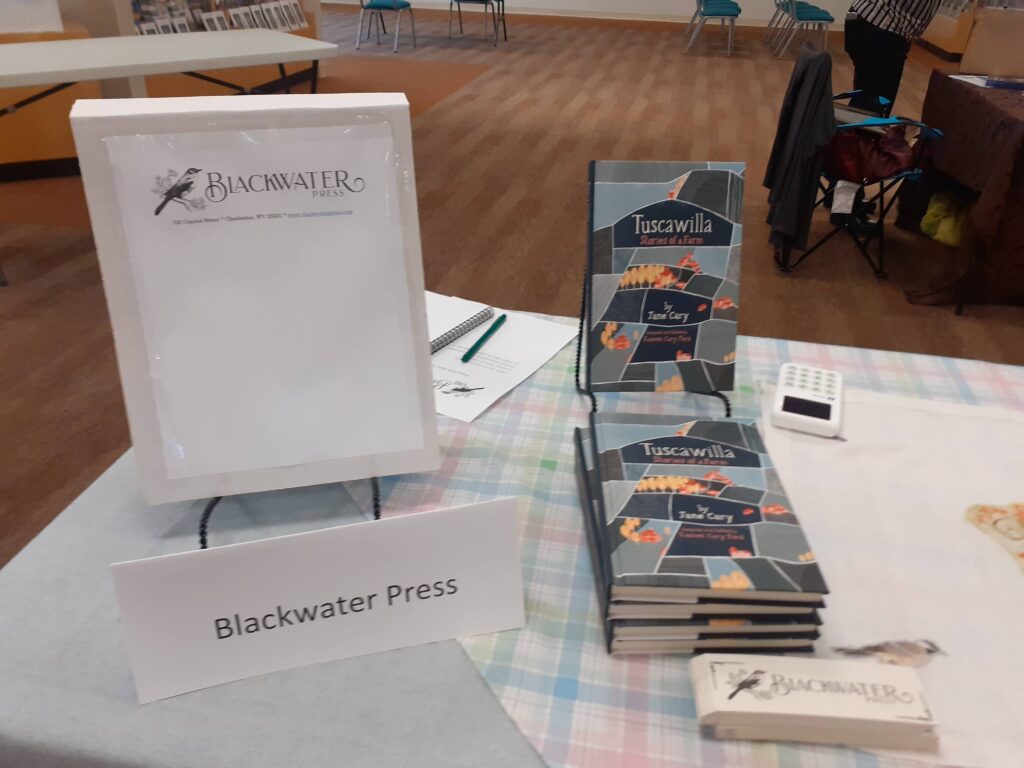
We have two new authors on our website: Cameron Alam and Kate Mueser, and their books both feature young women in new surroundings making unlikely friends. Cameron’s novel Anangokaa is the story of a family from the Isle of Mull who joined Lord Selkirk’s scheme to settle at Baldoon, Ontario, in 1804. This coming of age tale focuses on the second daughter, Flora, and her friendship with a young Native American man. Kate’s novel The Girl With Twenty Fingers, is set in present-day Munich and follows a young American woman, Sarah, who has spectacularly bombed out of music school and wants a fresh, ideally piano-free start. An unexpected friendship blossoms, and Sarah is able to accept how her life developed. Watch for this winter!
And, our next book, Ioulia Kolovou’s The Stone Maidens, will be published on October 17, and is now available for pre-order. This follows the life of Milagros Riquelme as she grows from a young girl with great aspirations into adulthood, hoping for more for her beloved daughter, and set against Argentina’s Dirty War.
For many, this is the beginning of the academic year. We’d like to remind our readers—and their friends—that we also edit. And we’re seeking proposals for our Interesting Lives series. And, another of our editing clients had a book accepted for publication: congratulations to Gloria Beth Amodeo, whose memoir God’s Ex-Girlfriend, was accepted by LG Publishing. From the three chapters we read, it’s a can’t miss!

